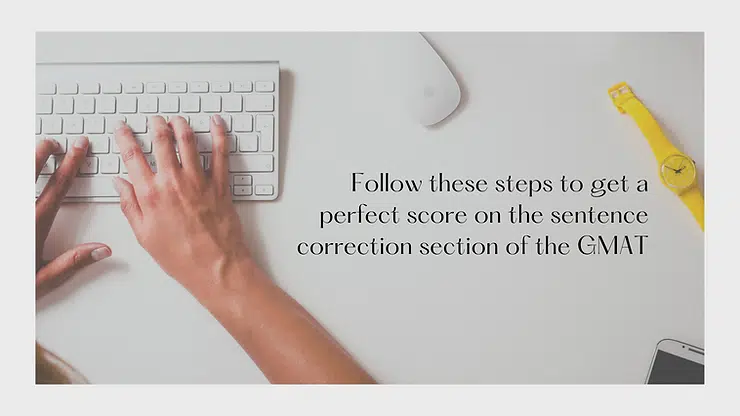UPDATE: the Sentence Correction Section will be removed from the GMAT in 2024.
GMAT SENTENCE CORRECTION CHECKLIST

Idioms
- HOW TO IDENTIFY AN IDIOM QUESTION? There will be an idiom in the sentence. For a full list of idioms, click here.
Study Tip: Make flashcards to memorize all the idioms. You can make flashcards based on our full list of idiomshttps://www.prepforsuccesstutors.com/post/idioms-on-the-gmat, or make a flashcard of an idiom when you come across it in a practice problem. Also, writing an example of how the idiom is used on the back of the flashcard can be helpful.
Parallel Structure
- HOW TO IDENTIFY A PARALLEL STRUCTURE QUESTION? The sentence must have multiple parts, which is typically indicated by conjunctions (FANBOYS – For, And, Nor, But, Or, Yet, So).
Example: An example is “I went not only to the store but also to the movies”. “I went” is the “stem”, while “to the store” and “to the movies” are the two sections that are parallel with one another. When you combine both sections with the stem, complete sentences are made: “I went to the store” and “I went to the movies”.
- STEPS TO SOLVE THE QUESTION:
1) Notice the sentence has multiple parts.
2) Find the “stem” and make sure it can be distributed to all parts of the sentence.
3) Make sure all parts of the sentence have the same structure.
- To learn more about Parallel Structure, click here.
Pronouns
- HOW TO IDENTIFY A PRONOUN QUESTION? The sentence must have pronouns (he/she/it/they/them/their) and the pronouns must change among all the answer choices.
- STEPS TO SOLVE THE QUESTION:
1) Notice the sentence has pronouns (he/she/it/they/them/their).
2) Find the antecedent (reference term)
3) Match the antecedent with the pronoun in terms of singularity and plurality.
4) To verify that you have the correct antecedent, plug that word in for the pronoun.
Comparisons
- HOW TO IDENTIFY A COMPARISON QUESTION? Look for comparison words (more, less, compared to, prefer, like, taller, etc.) as well as pronouns like that (singular) vs those (plural).
- STEPS TO SOLVE THE QUESTION:
1) Notice the sentence has comparison words, “that”, or “those”
2) Ask yourself what is compared to one another. The comparison MUST be the same concept. Meaning, compare food to food, location to location, etc.
Example: A correct example would be “The price of gas is comparable to the price of milk.” Notice how you are comparing the price of one item to the price of another item. It would be incorrect to say “the price of gas is comparable to milk”, which would be comparing the price of one item to just the other item.
Example: In the previous example, the sentence said the price, but another answer choice may say “The price of gas is comparable to that of milk.” Notice how the pronoun “that” is substituted for “price”. “That” can replace a singular noun and “those” can replace a plural noun.
Modifiers
Dangling Modifiers
- HOW TO IDENTIFY A DANGLING MODIFIER QUESTION? Look for an introductory phrase which is otherwise known as the dangling modifier.
- STEPS TO SOLVE THE QUESTION:
1) Find the introductory phrase
2) Confirm that the item that is doing the action in the introductory phrase is DIRECTLY AFTER the introductory phrase
Misplaced Modifiers
- HOW TO IDENTIFY A MISPLACED MODIFIER QUESTION? You will notice that all sentences have the same wording but the order of the sentences change.
- STEPS TO SOLVE THE QUESTION:
1) Notice the wording order changes among all answer choices.
2) Understand the logic of the sentence and make sure the modifiers (descriptions) are directly next to whatever it’s describing.
Subject-Verb Agreement
- HOW TO IDENTIFY A SUBJECT/VERB AGREEMENT QUESTION? You will notice that the verbs are changing (examples: has/have, was/were, walk/walks).
- STEPS TO SOLVE THE QUESTION:
1) Notice that the verbs change.
2) Find the subject by doing the following:
- 1) crossing out prepositional phrases
- On, to, by, for, with, in, at, of
- 2) crossing out additional information
- (add) ,add, – add-
3) Match singularity and plurality of subject and verb.
singular verbs have a tendency of having an “s”
Verb Tense/Verb Form
- HOW TO IDENTIFY A VERB TENSE QUESTION? Identify that the verbs are changing but NOT in terms of singularity and plurality (which would be subject/verb agreement).
- STEPS TO SOLVE THE QUESTION:
1) Identify that the verbs are changing but NOT in terms of singularity and plurality (which would be subject/verb agreement).
2) Identifying when the actions in the sentence occurred by using context clues.
Below are the most common types of verb tenses.
- Ongoing → ing
- Future → will
- Hypothetical → would
- Past → -ed
- Start in Part and Ended in Past → had
- Start in Part but continued to Present → has/have
Grammar
- HOW TO IDENTIFY A VERB TENSE QUESTION? First, check all the other rules above. If the problem does not fall into one of those categories, it may be based on grammar.
- STEPS TO SOLVE THE QUESTION:
1) Check that the sentence has a subject (noun) and a predicate (verb).
2) Check that punctuation is correct.
3) Check that conjunction are correct.
Wordiness
- HOW TO IDENTIFY A VERB TENSE QUESTION? This is the last category that you want to regard. Basically, if it doesn’t fall into any other category, then it’s likely to be wordiness.
- STEPS TO SOLVE THE QUESTION:
1) Identify if the sentence is redundant (example: Currently now).
2) Remove any “wordy” parts of the sentence. For example, the word “being”.
3) Make sure the logic of the sentence makes sense.




